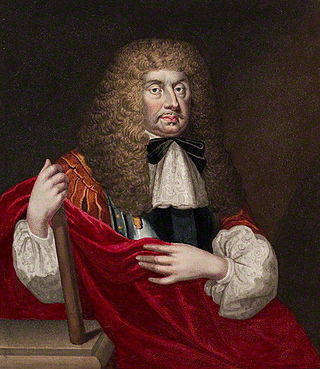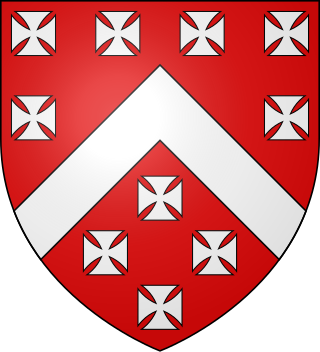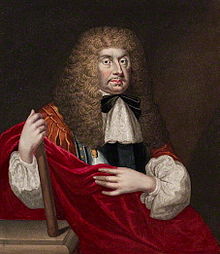
John Berkeley, 1st Baron Berkeley of Stratton of Berkeley House in Westminster and of Twickenham Park in Middlesex, was an English royalist soldier, politician and diplomat, of the Bruton branch of the Berkeley family. From 1648 he was closely associated with James, Duke of York, and rose to prominence, fortune, and fame. He and Sir George Carteret were the founders of the Province of New Jersey, a British colony in North America that would eventually become the U.S. state of New Jersey. The territorial designation of his title refers to his role at the Battle of Stratton, Cornwall, in 1643 at which the Royalists destroyed Parliament's field army in Devon and Cornwall.

Duke of Leinster is a title in the Peerage of Ireland and the premier dukedom in that peerage. The subsidiary titles of the Duke of Leinster are: Marquess of Kildare (1761), Earl of Kildare (1316), Earl of Offaly (1761), Viscount Leinster, of Taplow in the County of Buckingham (1747), Baron of Offaly, Baron Offaly (1620) and Baron Kildare, of Kildare in the County of Kildare (1870). The viscounty of Leinster is in the Peerage of Great Britain, the barony of Kildare in the Peerage of the United Kingdom, and all other titles in the Peerage of Ireland. The courtesy title of the eldest son and heir of the Duke of Leinster is Marquess of Kildare. The Duke of Leinster is the head of the House of Kildare.
The Peerage of the United Kingdom is one of the five Peerages in the United Kingdom. It comprises most peerages created in the United Kingdom of Great Britain and Ireland after the Acts of Union in 1801, when it replaced the Peerage of Great Britain. New peers continued to be created in the Peerage of Ireland until 1898

Marquess of Lansdowne is a title in the Peerage of Great Britain created in 1784, and held by the head of the Petty-Fitzmaurice family. The first Marquess served as Prime Minister of Great Britain.

The titles of Earl of Hertford and Marquess of Hertford have been created several times in the peerages of England and Great Britain.

Baron FitzWalter is an ancient title in the Peerage of England. It was created on 24 June 1295 for Robert FitzWalter. The title was created by writ, which means that it can descend through both male and female lines.

The title Baron Berkeley originated as a feudal title and was subsequently created twice in the Peerage of England by writ. It was first granted by writ to Thomas de Berkeley, 1st Baron Berkeley (1245–1321), 6th feudal Baron Berkeley, in 1295, but the title of that creation became extinct at the death of his great-great-grandson, the fifth Baron by writ, when no male heirs to the barony by writ remained, although the feudal barony continued. The next creation by writ was in 1421, for the last baron's nephew and heir James Berkeley. His son and successor William was created Viscount Berkeley in 1481, Earl of Nottingham in 1483, and Marquess of Berkeley in 1488. He had no surviving male issue, so the Marquessate and his other non-inherited titles became extinct on his death in 1491, whilst the barony passed de jure to his younger brother Maurice. However, William had disinherited Maurice because he considered him to have brought shame on the noble House of Berkeley by marrying beneath his status to Isabel, daughter of Philip Mead of Wraxhall, an Alderman and Mayor of Bristol. Instead, he bequeathed the castle, lands and lordships comprising the Barony of Berkeley to King Henry VII and his heirs male, failing which to descend to William's own rightful heirs. Thus on the death of King Edward VI in 1553, Henry VII's unmarried grandson, the Berkeley inheritance returned to the family. Therefore, Maurice and his descendants from 1492 to 1553 were de jure barons only, until the return of the title to the senior heir Henry, becoming de facto 7th Baron in 1553. Upon his death he was succeeded by his relative George Harding.

Viscount Falmouth is a title that has been created twice, first in the Peerage of England, and then in the Peerage of Great Britain. The first creation came in the Peerage of England in 1674 for George FitzRoy, an illegitimate son of King Charles II by Barbara Villiers. He was created Earl of Northumberland at the same time and in 1683 he was made Duke of Northumberland. However, he left no heirs, so the titles became extinct at his death in 1716.
Baron Kerry is an ancient title in the Peerage of Ireland, named after County Kerry. It was created circa 1223 for Thomas FitzMaurice, Lord OConnello, son of Maurice FitzGerald, Lord of Llanstephan.

Viscount Clifden, of Gowran in the County of Kilkenny, Ireland, was a title in the Peerage of Ireland. It was created on 12 January 1781 for James Agar, 1st Baron Clifden. He had already been created Baron Clifden, of Gowran in the County of Kilkenny, in 1776, also in the Peerage of Ireland. The Viscounts also held the titles of Baron Mendip in the Peerage of Great Britain from 1802 to 1974 and Baron Dover from 1836 to 1899, when this title became extinct, and Baron Robartes from 1899 to 1974, when this title became extinct, the two latter titles which were in the Peerage of the United Kingdom. The interrelated histories of the peerages follow below.

Baron FitzHardinge, of the City and County of the City of Bristol, was a title in the Peerage of the United Kingdom. It was created on 5 August 1861 for the naval commander and politician Admiral Sir Maurice Berkeley. He was among pre-official marriage so illegitimate sons of Frederick Berkeley, 5th Earl of Berkeley and his wife. Among his brothers were Thomas Berkeley, 6th Earl of Berkeley and William Berkeley, 1st Earl FitzHardinge.

Earl of Bellomont, in the Kingdom of Ireland, was a title that was created three times in the Peerage of Ireland. The first creation came on 9 December 1680 when Charles Kirkhoven, 1st Baron Wotton, was made Earl of Bellomont. He had already been created Baron Wotton, of Wotton in the County of Kent, in the Peerage of England on 31 August 1650. He was childless and both titles became extinct on his death in 1683.
Earl of Barrymore was a title in the Peerage of Ireland. It was created for David Barry, 6th Viscount Buttevant, in 1627/28. Lord Barrymore held the subsidiary titles of Baron Barry and Viscount Buttevant in the County of Cork in Ireland. After the death of the 8th Earl in 1823, all these titles became extinct.

The Berkeley family is an ancient English noble family. It is one of only five families in Britain that can trace its patrilineal descent back to an Anglo-Saxon ancestor. The Berkeley family retains possession of much of the lands it held from the 11th and 12th centuries, centred on Berkeley Castle in Gloucestershire, which still belongs to the family.

Viscount Fitzhardinge is an extinct title in the Peerage of Ireland. It was created on 14 July 1663 for Charles Berkeley, later Earl of Falmouth, of the Bruton branch of the Berkeley family, with the subsidiary title of Baron Berkeley of Rathdowne, also in the Peerage of Ireland. It passed by special remainder to Charles' father, Charles, then to Maurice, elder brother of the first viscount, and then to their younger brother, John. The title became extinct on John's death in 1712.
FitzHardinge is a surname. Notable people with the surname include:
William FitzHardinge Berkeley, 1st Earl FitzHardinge, known as The Lord Segrave between 1831 and 1841, was a British landowner and politician.
Charles Paget Fitzhardinge Berkeley, 3rd Baron FitzHardinge, styled The Honourable Charles Berkeley between 1861 and 1896, was a British Liberal politician.

Sir Maurice Berkeley of Bruton in Somerset and of Berkeley House, Clerkenwell, Middlesex, served as Chief Banner Bearer of England to Kings Henry VIII and Edward VI and to Queen Elizabeth I, and rose rapidly in the Tudor court. He came from a cadet branch of the great Berkeley family of Berkeley Castle in Gloucestershire, but in his career, his initial advantage was due to his mother's second marriage to Sir John FitzJames, Lord Chief Justice of the King's Bench 1526–1539, which by 1538 had brought him into the household of Thomas Cromwell, from which he passed into the royal household by 1539.
Villiers is an aristocratic family in the United Kingdom. Over time, various members of the Villiers family were made knights, baronets, and peers. Peerages held by the Villiers family include the dukedoms of Buckingham (1623–1687) and Cleveland (1670–1709), as well as the earldoms of Anglesey (1623–1661), Jersey, and Clarendon. Perhaps the most prominent members of the family were those who received the two dukedoms: George Villiers, 1st Duke of Buckingham (1592–1628) rose to fame and influence as favourite of King James I of England, while Barbara Villiers, Duchess of Cleveland (1640–1709) became a mistress of King Charles II of England, by whom she had five children.











